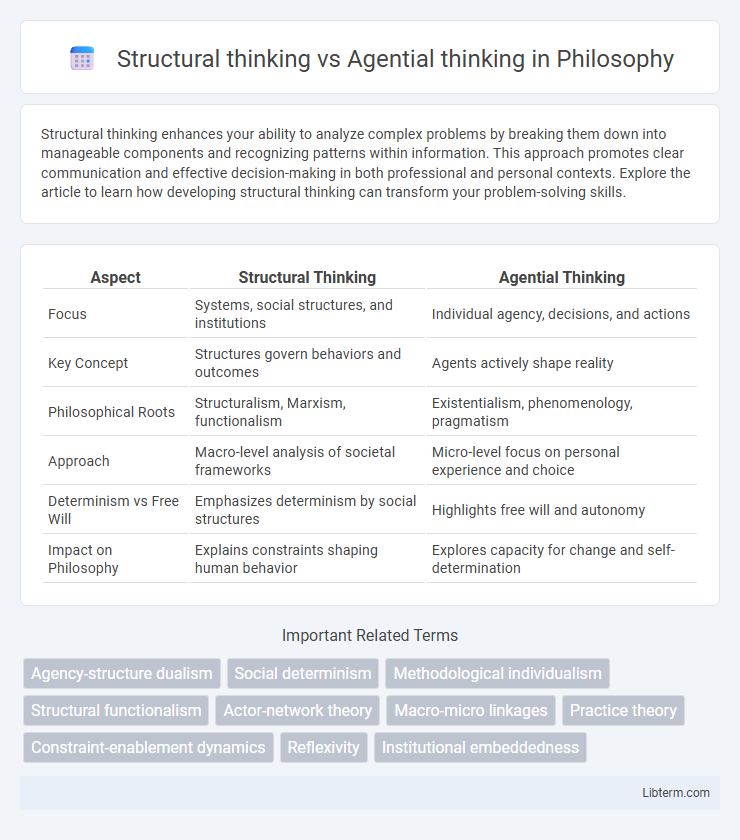Structural thinking enhances your ability to analyze complex problems by breaking them down into manageable components and recognizing patterns within information. This approach promotes clear communication and effective decision-making in both professional and personal contexts. Explore the article to learn how developing structural thinking can transform your problem-solving skills.
Table of Comparison
| Aspect | Structural Thinking | Agential Thinking |
|---|---|---|
| Focus | Systems, social structures, and institutions | Individual agency, decisions, and actions |
| Key Concept | Structures govern behaviors and outcomes | Agents actively shape reality |
| Philosophical Roots | Structuralism, Marxism, functionalism | Existentialism, phenomenology, pragmatism |
| Approach | Macro-level analysis of societal frameworks | Micro-level focus on personal experience and choice |
| Determinism vs Free Will | Emphasizes determinism by social structures | Highlights free will and autonomy |
| Impact on Philosophy | Explains constraints shaping human behavior | Explores capacity for change and self-determination |
Defining Structural Thinking
Structural thinking emphasizes understanding systems, patterns, and relationships within complex frameworks, analyzing how individual parts interact to form a cohesive whole. It prioritizes the identification of underlying structures that shape behaviors, processes, and outcomes across various contexts, such as organizations or social systems. This approach enables the prediction and management of systemic dynamics by focusing on recurring patterns rather than isolated events.
Understanding Agential Thinking
Agential thinking emphasizes individual autonomy, decision-making, and the capacity to act independently within social contexts, contrasting with structural thinking which prioritizes systemic constraints and social institutions. It highlights how personal choices and intentions shape outcomes despite overarching structural influences. Understanding agential thinking involves recognizing the dynamic interplay between human agency and social structures, focusing on empowerment, creativity, and proactive problem-solving.
Key Differences Between Structural and Agential Approaches
Structural thinking emphasizes the influence of overarching systems, institutions, and social structures in shaping individual behavior and societal outcomes, highlighting constraints and patterns beyond personal control. Agential thinking prioritizes individual choices, motivations, and actions, stressing human creativity and responsibility in shaping social realities. The key difference lies in whether behavior is viewed primarily as determined by external structures or driven by autonomous agency.
Historical Evolution of Structural and Agential Theory
Structural thinking emerged prominently in the mid-20th century through the works of sociologists like Talcott Parsons and Immanuel Wallerstein, emphasizing enduring social frameworks shaping individual behavior and institutional patterns. Agential thinking, rooted in phenomenology and symbolic interactionism, gained traction with theorists such as Anthony Giddens and Pierre Bourdieu, highlighting individuals' capacity to act autonomously within, yet also transform, structural constraints. The historical evolution of these theories reflects a dialectic where structural paradigms underscore systemic forces, while agential theories foreground human intentionality and adaptability in social processes.
Advantages of Structural Thinking
Structural thinking enhances problem-solving efficiency by organizing complex information into clear, systematic frameworks that reveal underlying patterns and relationships. This method promotes consistency and scalability, enabling better decision-making in large organizations and complex systems. Utilizing structural thinking helps identify root causes and long-term impacts, improving strategic planning and resource allocation.
Benefits of Agential Thinking
Agential thinking empowers individuals to actively influence outcomes by focusing on personal agency, decision-making, and problem-solving capabilities rather than predetermined structures. This mindset enhances adaptability, fosters innovation, and encourages proactive behavior in complex and dynamic environments. Emphasizing agential thinking improves leadership effectiveness and drives organizational change by promoting accountability and creative solutions.
Real-World Examples: Structure vs Agency
Structural thinking emphasizes how social systems and institutions shape individual behavior, illustrated by poverty often being linked to institutional inequalities like limited access to education or healthcare. Agential thinking highlights personal choice and autonomous actions, as seen in entrepreneurs overcoming socio-economic barriers through innovation and determination. Real-world examples such as the civil rights movement demonstrate the interplay, where collective agency challenges structural constraints to achieve social change.
Integrating Structural and Agential Perspectives
Integrating structural and agential perspectives enables a comprehensive understanding of social dynamics by recognizing how overarching social systems influence individual actions while acknowledging personal agency in shaping those structures. Structural thinking highlights patterns, institutions, and constraints that guide behavior, whereas agential thinking emphasizes autonomy, decision-making, and intentionality at the individual level. Combining these approaches facilitates nuanced analyses in sociology, organizational theory, and political science, revealing how agency and structure interact dialectically to produce social change and continuity.
Challenges in Balancing Structure and Agency
Balancing structural thinking, which emphasizes societal systems and institutions, with agential thinking, focusing on individual autonomy and decision-making, presents challenges in accurately analyzing human behavior. Structural constraints often limit individual agency, making it difficult to determine the extent to which people can enact change within established frameworks. Researchers must navigate this interplay to develop nuanced theories that incorporate both systemic influences and personal initiative in social phenomena.
Future Directions in Social Theory
Future directions in social theory emphasize integrating structural thinking, which analyzes overarching systems and institutions, with agential thinking that highlights human autonomy and decision-making. Emerging frameworks explore how macro-level structures shape individual behaviors while recognizing the capacity for agency to transform social environments. This dialectic approach advances a nuanced understanding of social dynamics, fostering interdisciplinary research and innovative methodologies in sociology and related fields.
Structural thinking Infographic

 libterm.com
libterm.com